Spotlight on John Tully
May 9, 2012

TID:
John, this is a surprising picture. Please tell us some of the background.
JOHN:
First, thanks a lot to you, Ross, and the rest of the people behind TID for the opportunity to be included among such talented folks and for the opportunity to share my experience. Hopefully, others can learn something from it.
It was a pretty typical assignment: we heard U.S. First Lady Michelle Obama would be visiting a local community center preschool class then giving a press conference afterwards to promote her Let's Move! healthy living initiative. Like many events dealing with the Secret Service, press is required to arrive early to setup, get the pat-down and then wait for the arrival. So I arrived with time to spare, received the metal detector scan, met up with the reporter and a woman told me to head downstairs to the yellow walled gym and look for a tall man. I would come to know this man as 'Tall Paul.' He was one of the coordinators of the event.
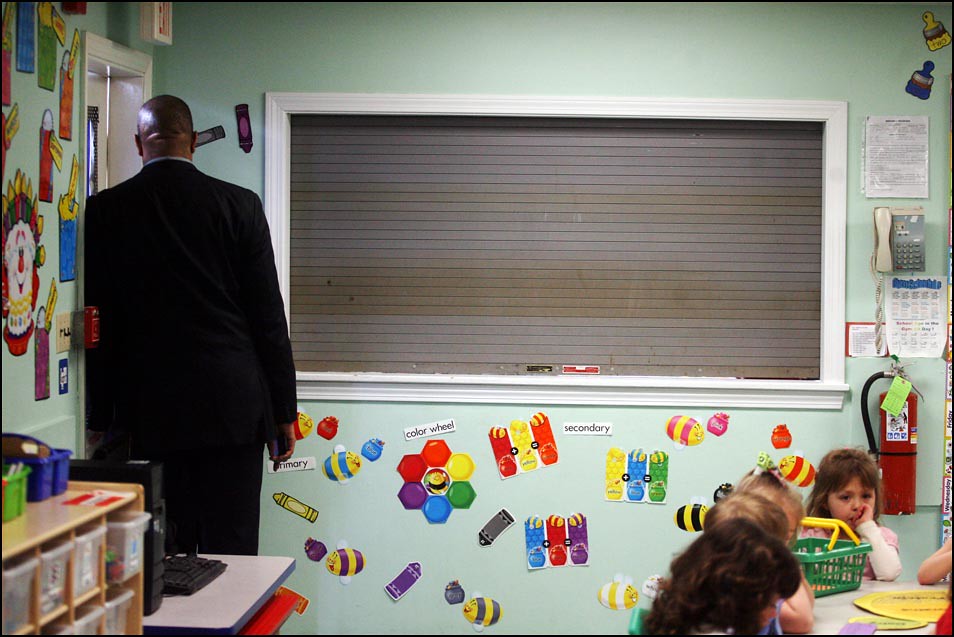
Tall Paul notified the reporter and myself that we would be in the press pool with a few others. The press pool is basically a group of journalists that are selected and granted extended access to a few additional 'opportunities' with the condition they write a pool report or share images with publications not in the pool. Naturally The Associated Press was there, I believe New Hampshire Public Radio and a local television crew. Close to the First Lady's arrival the pool was ushered from the gym to a classroom full of preschoolers.
Right before entering the classroom we heard a speech about how we should shoot this and make it look like it wasn't a photo opportunity. Work it so we can get our 'great photos,' as it was put to us. I was thinking to myself, "Oh, hell no." We all knew it was a photo opportunity, especially after being corralled behind a velvet rope in the corner of a classroom, but hearing it makes me feel dirty. But I was there for the newspaper and part of the pool so I couldn't just snub my nose and walk away. And it wasn't the first photo op I've had to shoot. We just had the New Hampshire Presidential Primaries not too long before, which was filled with these 'opportunities.' They can actually be pretty great to shoot and even just to watch, if you step outside the scrum and look back in at the scene, then see what people shot and how they chose to represent reality that day.
So we entered the classroom to a bunch of excited preschoolers curious at the sudden entourage of equipment and journalists. Tall Paul did a rhythmic clap to get the kids' attention, the kids mimicked, and all was quiet. Pretty awesome actually. You could tell he had been working hard to make this run perfectly. We stood around for about 15-20 minutes, peaking out the blinds, staring at the one door in and out of the classroom.
TID:
What was going through your mind when you began the shoot?
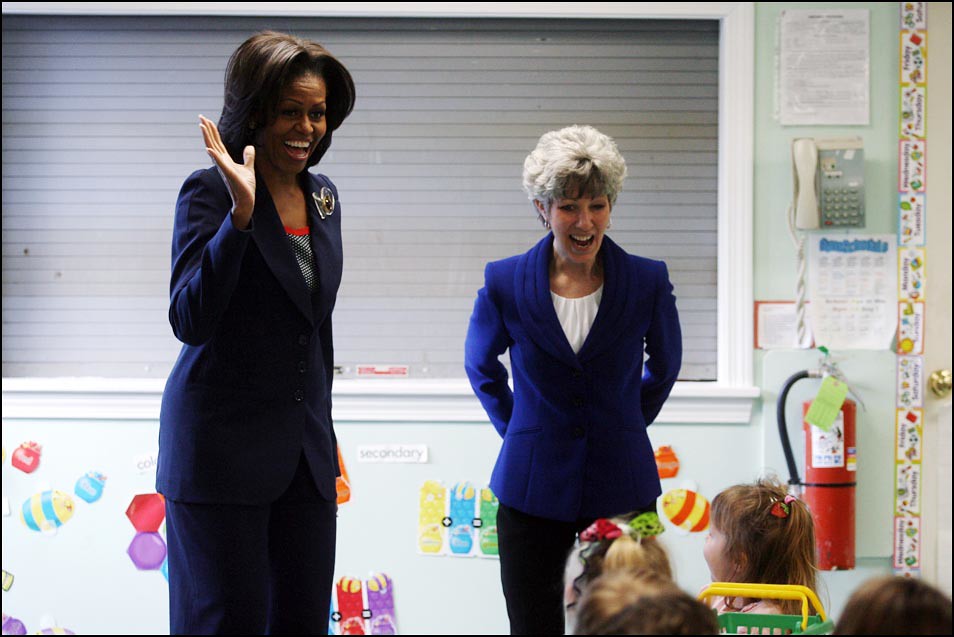
JOHN:
I think there's an initial surface checklist in photographers' heads when they're shooting. How's the light? What lens should I use? Where should I be? Hopefully I get something in focus. Then you move out of that surface and start thinking about the scene, the relationships, a broader picture. Ideally at the Concord Monitor, we don't shoot press conferences, but if there's one of significance, such as Mrs. Obama coming to town, I like to think we do everything in our power to make sure we don't run a picture of a talking head at a podium. So, I make a few of those talking head photos to cover my butt in case they need a mug or something down the road, but I try to look for something interesting and relevant happening on the fringes. I try to make the best of any situation, but when you're thrown into a situation like a press conference, eventually you have to realize it for what it is and what it is not. It is part of the job, it is not the best opportunity for intimate, storytelling photographs. Of course, there's potential for something unexpected to happen, like when a shoe was thrown at George Bush in Iraq, the assassination of Japanese Socialist leader Inejiro Asanuma or the famous Dewey Defeats Truman photograph.
Covering the primaries in New Hampshire popped in my head and I thought about what I could apply to this situation. Most times it's anticipation. Anticipating and understanding that if there are 50 people trying to squeeze through one door to follow a candidate into an already packed diner that comfortably holds 20, most likely you're not getting in the front so be the first to find the back door. On many occasions I wouldn't even bother and I was able to get access to things I probably shouldn't have. But this was different. It wasn't a frenzy. It was well-orchestrated event put on by The White House for the First Lady. There's little wiggle room.
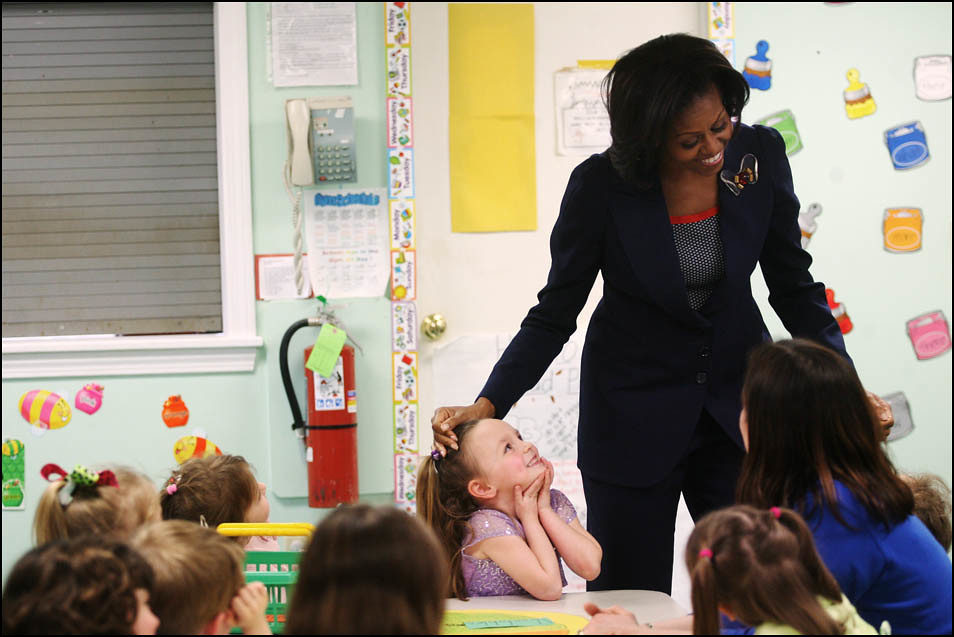
Of course you still try to wiggle, but this time it resulted in two Secret Service men moving in asking me to return behind the ropes. Another tool in the elusive camera bag is to play dumb. I can't remember who I first heard it from but, "Don't ask for permission, ask for forgiveness." Most of the time it holds true. Although, you need to weigh each situation differently. You don't want to be the photographer who runs out on the basketball court ruining other people's photographs. But at the same time you don't want to be a person who sits by and just follows the scrum. So maybe I miss something that someone else shot. Great, they've got it and if it's that remarkable, by all means, hold what I shot and use that photo.
Above all you need to have respect for other journalists and yes, sometimes even the public relations people. And the people around you. I can't remember how many times I heard and saw people storm out of events because some member of the press was rude or dismissive of their presence.

TID:
Now, onto the moment. Please describe how you put yourself into position where you could make this image.
JOHN:
The pool was positioned behind a rope in the corner of the classroom. Across the room stood Mrs. Obama and the preschoolers. By this time, she made her rounds visiting most of the tables, except the one closest to the press. I switched from a body with a long lens to one with a wide and tried to frame something with the other pool journalists to set the scene and offer more context, but it just wasn't working. It was too wide and she was too far back. So, I picked up the long lens again and that's when they started gathering for the dance.
At this point, I knew I made some photos that would work, and were probably better than anything out of the press conference, but I wasn't satisfied. The dance was something called the bunny hop dance, and naturally, all the kids were going wild and having a great time. I don't know Mrs. Obama and I've photographed her only once or twice before, so I don't really know her honest visual personality, posture and body language. But she seemed a little reserved throughout the visit.
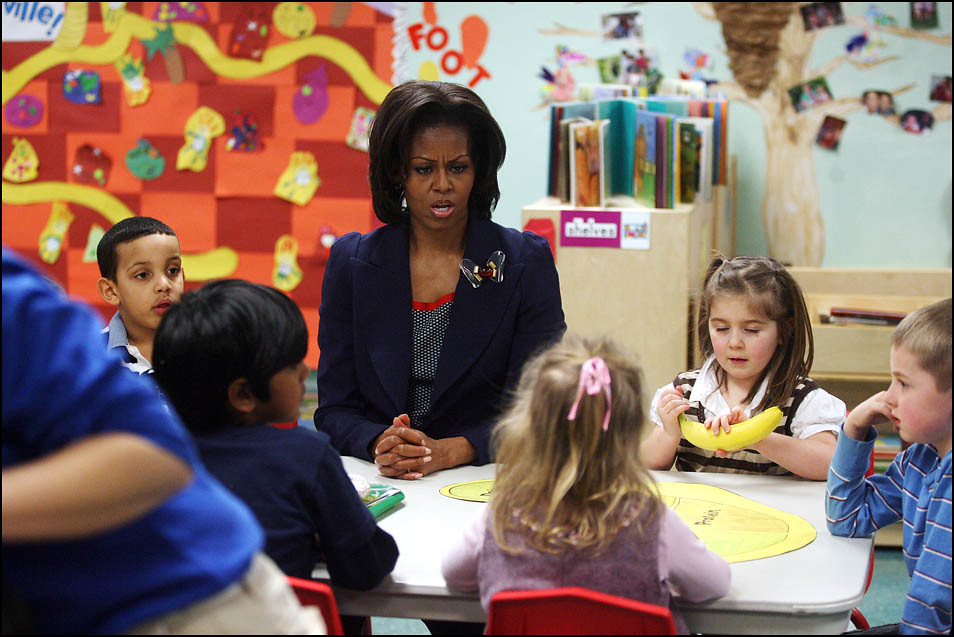
But during the dance, she started to relax a little. It appeared to be a moment where she dropped her guard and just enjoyed the 30 seconds or so with some kids who were excited to see her. Ultimately, that's why we chose that photo. It was an image of the First Lady that people don't always see because she is so well kept and aware.
TID:
What surprised you about the assignment?
JOHN:
At the assignment, I was surprised the reporter and I were in the press pool.
Yet the biggest surprise was at just how many people wrote and actually called Felice Belman, head editor at the Monitor, to say the photo was unflattering. So much so that she thought she would use this as an opportunity to explain to people our thoughts behind choosing the photo. I think being open and transparent with our readers is beneficial and if nothing else it confronts those who think we're operating with an agenda. One commenter said that at least he now knows the Monitor runs unflattering photos of BOTH Republicans and Democrats.
The day of the photo was taken, when I got back to the office, Felice and Ric Tracewski, managing editor, came over to see the photos and immediately chose the dancing photo. It was between that photo and another one of Mrs. Obama sitting up tall, hands on the table, talking to kids. Alex Cohn, the photo editor, was pushing for that because it looked as if the First Lady was discussing something serious with a diplomat, and yet these were preschoolers. It went back and forth with some discussion. I was asked my opinion and I sided with the dancing photo because it seemed real. I knew, however, a few of our outspoken readers would have a comment about it.
One of the hardest parts for me is seeing a comment to a story or photograph I worked on that assumes something that isn't true, that I have an agenda to make someone look bad. I got into photojournalism and am sticking with it because it is real. I think there is so much out there that is manipulated and fake and posed and set up that it's important to be fair and accurate and document what actually IS the reality of our time. So while there's this philosophy that objectivity is impossible, I believe a level exists where you set aside your personal beliefs and document what's happening.
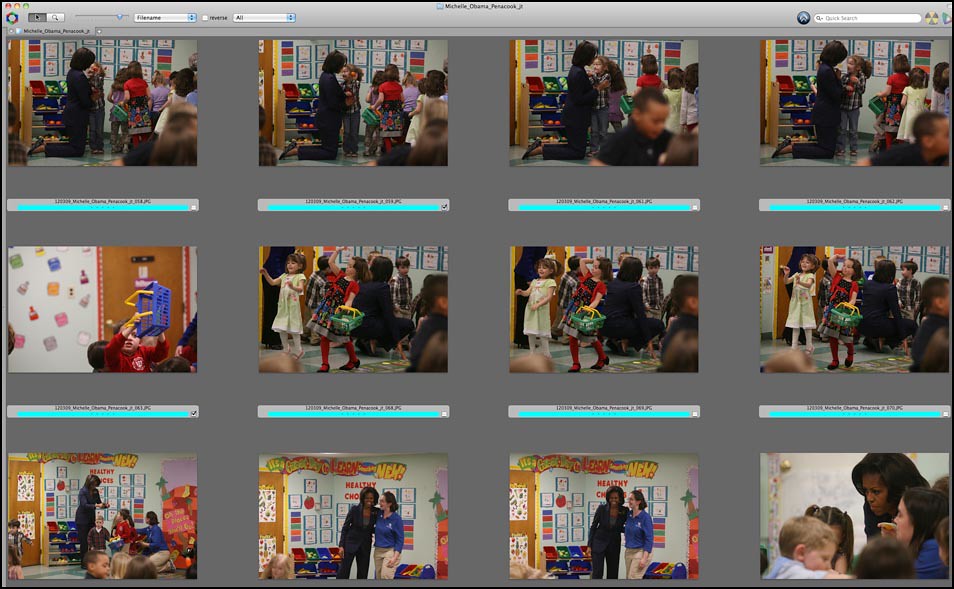
TID:
This image caused some unexpected controversy. Can you talk about how you handled this as a staff?
JOHN:
This was all Felice. I've dealt with comments in the past largely by trying to ignore them because they're usually snide remarks left by an anonymous writer. The way Felice handled this situation was an eye-opener for me. She saw readers' comments and complaints as an opportunity to educate them about what we do. So she wrote a piece called, 'Here's a chance for you to play editor' and invited readers to weigh in. We posted the photo we chose along with four others: three from the class, and a podium shot from the press conference.
I genuinely believe the Monitor is a place where most of the staff cares about what they're doing and respect everyone's opinions. Felice asked me to write a little about my thoughts and what was going through my head so she could include it in the article. The Monitor has a phenomenal reputation for photojournalism that I've known about since my freshman year of college. While things have changed, the foundation for photojournalists to do solid work throughout the community is still very much alive and there's a lot of pressure to keep that level high. Felice is very much a reason why this foundation still exists and it's obvious she cares about not only the writing staff but the photographers as well.
While some people still subscribed to one conspiracy theory or another, the majority who wrote in agreed with our choice and they were very supportive. We did receive this note from a reader. And it's the small things like a letter that makes this job worth doing:
"I love the picture that was chosen. I loved it immediately when I saw it and for reasons similar to those given by the photographer. I think Michelle Obama is pretty and has a pretty smile, but I'm not looking for a First Lady (or usually anyone else) who is a "pretty face." What I'm looking for in a First Lady is Eleanor Roosevelt. I'm looking for a First Lady who exudes empathy, who connects to people and not just people who are like her - in size or color or religion or politics. What I see in that picture is the biggest child in the room, the one who is at least as much a kid, at least as happy and feeling the moment and into the spirit of childhood as any kid in that picture and as any kid can and ought to be. Great choice, Monitor."
TID:
Do you have any additional thoughts or advice about daily photojournalism?
JOHN:
Daily photojournalism is about your backyard. It's about taking time to know your community and commit to telling its stories. Being a community photojournalist is a fantastic opportunity to create a body of work about life in one slice of the world. I love that and it's a direction I want to take my photography. At the end of the day, through the personal ups and downs that we all share, there's really no better feeling than when you're with people in their element, letting you tag along with a camera through thick and thin. It's about them and nothing else matters.
I think it's important for newspaper photo staffs to focus less on event coverage and more on the stories that go beyond that surface. But to move beyond that one-day mindset requires a commitment to planning and communication throughout the newsroom so photographers are in the right place at the right time while the story is unfolding, no excuses. Setting them up for success rather than just filling a space in the paper.
On a personal side, photojournalism in my life is also trying to figure out who I am and what I have to say. I started working for the local community newspaper while I was in high school. Looking back, I loved it and owe a lot to Dave Ellis who took me under his wing. But starting out young I didn't know this industry, this art, is about what you have to say. And there's a lot of pressure to figure that out. At the time I thought it was just about light and composition and moments. It wasn't until working at the Midland Daily News with Ryan Wood that I really began to understand this idea of community and connection through making photos.
I'm restless and curious and there's still this desire to abandon everything and figure out what I have to say. At the same time there's a pressure and responsibility of having a job at a newspaper, to suck it up and push on hoping that one day it will fall into place. But there are a lot of late nights and spent cigarettes trying to figure this out. Working with Andrea Morales in Concord has been great because she challenges the way I think and respond to photography and that's important as not to fall to routine. I only hope I'll still be doing this in some capacity in a year from now and I remind myself that I'm here by freak chance and there are others who would love to be at a newspaper. There's a responsibility to try my best at every assignment, even a press conference.

::::BIO::::
John Tully is a 2008 graduate of the University of Missouri School of Journalism. During his time in Missouri, he also studied at the Danish School of Journalism in Århus, Denmark. After graduating, he interned with The Washington Times and joined the staff of the Midland Daily News in Midland, Michigan. In May 2010, he joined the staff of the Concord Monitor in Concord, New Hampshire. Born in Massachusetts and moving around the country his whole life, he feels coming back to New England is coming home and a chance to finally find his roots.